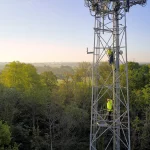SpaceX Burnt Up 472 Starlink Broadband Satellites in Last 6 Months

SpaceX has revealed to the Federal Communications Commission (FCC) that it deorbited 472 Starlink ultrafast broadband satellites – burning them up in Earth’s atmosphere – during the six-month period from December 2024 to May 2025 (2.6 per day), which marked a significant increase from previous period of six-months when just 73 met a fiery demise.
At present Starlink has around 7,900 satellites in Low Earth Orbit (c.4,300 are v2 Mini / GEN 2A) – mostly at altitudes of c.500-600km – and they’ll add thousands more by the end of 2027. Residential customers in the UK usually pay from £75 a month, plus £299 for hardware (currently free for most areas) on the ‘Standard’ unlimited data plan (kit price may vary due to different offers), which promises UK latency times of 28-36ms, downloads of 103-258Mbps and uploads of 15-26Mbps. Cheaper and more restrictive options also exist for roaming users.
However, smaller LEO satellites, such as those from operators like Starlink, OneWeb (Eutelsat), Amazon (Kuiper) and others, are designed to have a relatively short lifespan (e.g. Starlinks are designed to last for 5 years) – like absurdly expensive consumables. After that they will be directed back down by operators to burn up (incinerate) in our atmosphere or – if they fail (no operator control) – they’ll be pulled down by gravity and atmospheric drag in the space of a few short years.
Advertisement
Suffice to say that, given the rise in launch rates over recent years, it is inevitable that Starlink will suffer a notable rise in retirements as the years roll by (particularly of their GEN1 / first generation spacecraft). But independent evidence from earlier this year had already indicated that SpaceX was deorbiting more Starlinks than expected (here) and the latest official data (credits to PC Mag) confirms that trend.
For example, most of the deorbited Starlinks (430) were indeed GEN1, but they were also less than 5 years old and the rest belonged to the second-generation (GEN2) network. Suffice to say that it’s not clear quite why so many Starlinks have been de-orbited at this time, although a small portion will have done so due to failure and some would have been reaching the end of their life. But the others remain a mystery.
Most such satellites burn up without incident in the atmosphere, although there have been exceptionally rare cases where chunks of metal did survive all the way back down to the surface (GEN2/3 satellites are now designed to be better at disintegration during atmospheric re-entry). Some scientists also remain concerned about the release of potentially harmful chemicals into the atmosphere, which they fear might damage the sensitive ozone layer etc.
Mark is a professional technology writer, IT consultant and computer engineer from Dorset (England), he also founded ISPreview in 1999 and enjoys analysing the latest telecoms and broadband developments. Find me on X (Twitter), Mastodon, Facebook, BlueSky, Threads.net and Linkedin.
« Rural Broadband ISP Wildanet Launch 2Gbps FTTP for South West England






















































What a waste of resources, and yet we are told to recycle, while companies can just waste.
Do you perhaps know of a way to recycle a satellite or are we not supposed to use satellites until it is economically viable to recycle them ..?
okay but
1. They only have a life span of 5 years and.
2.They burn up on re entry – so where is the waste?
Just curious as you seem to be a bit of an expert on this field no?
Use satellites for important stuff, Making more money for Musk is not important.
Grabbing hold of satellites have been looked at, but no doubt cost too much money.
@, you are not very bright, what do you think is used to make them in the first place, scotch mist?
Resources are used to make them in the first place, just like with the rockets that are sent up or destroyed just for a rich man’s pleasure.
We are told we are using too many resources, and we should cut down, told not to do this, not to do that because it is harmful to the planet, well tell that to Musk and co.
Well, the fact they burn up means there is nothing to recycle, which surely is his point.
Also, the products of that atmosperic incineration are likely to have a detrimental effect on the ozone layer, since they consist of ozone-depleting compounds (just as the ozone layer is recovering from CFCs damage). See Starlink forum discussion for a few links.
The odd satellite or three burning up is not a problem, but the planned, continual de-orbiting of the mega constellations of Musk, Bezos, and others will likely lead to a problem. As usual, we, as a species, continue to use the atmosphere and water bodies as convenient waste-dumping grounds on the basis they are an almost infinite low- to zero-cost disposal medium, which ultimately they are not.
@HR2Res, Well put.
15,000 tonnes of meteor material burns up in our atmosphere every year. Starlink satellites burning up will only be 10% of that amount.
Yes, meteors do affect the ozone layer. However, absent additional ozone-depleting chemicals, the ozone layer heals itself reasonably quickly. It always has (though our use of CFCs has severely curtailed its ability to naturally recover). The problem with satellite incineration is the additional annual mass that is added and the particular chemistry involved with aerosolised aluminium oxide. Likely changes to the polar vortex will affect weather, climate, and ozone recovery and will also add to ozone depletion. If it was just Starlink then the effects might (might!) be tolerable. It’s the Kuiper project and various other space-faring nations’ plans to do what Musk has done and continues to do that will be the problem. The current projections are that satellite deorbiting could add 40% annually to the natural background level, and that’s not likely to be insignificant in its effects.
Out of interest how much does each Starlink satellite cost (including deployment)? I presume it would be a lot less than the geostationary satellites like Astra 2 that Sky uses.
Estimates vary but generally range from $250,000 to $1,000,000, depending on which GEN we’re talking about, the launch platform and other costs. The $250k figure is more reflective of the raw manufacturing cost, but if you add launch costs, I’d say $500k is a reasonable middle figure guesstimate.
By my rough calculations, for the number of satellites deployed vs the customer base, they need to take about $860 per customer per 5 year lifespan of each satellite. If you assume running costs over that period treble the figure then you would need to extract $2580 per customer over a 5 year period. Given at current exchange rates a UK customer pays $6165 over that period it looks like it could be quite a lucrative business.
@Big Dave
Correct – they’re throwing off cash now, the whole point being to fund the Starship and Mars shennanighans.
Wouldn’t surprise me if they got to 80% gross profit or more once Starship is in operation. There’s a reason Amazon want in on the game.
I’d be interested on your workings, by my maths it’s just over 1Million per piece launched.
@-says: I took Mark’s $500,000 figure and assumed once you added in all other running costs over its 5 year lifespan e.g. ground stations, staff, licensing costs it would eventually be 3X its initial deployment costs I.e. $1.5 million per satellite. 1.5 million X 7900 = $11.85bn. Divide that by 4.6 million customers and that is $2576 per customer
Posted here a few times about the apalling waste of starlink leo years ago, in an era where were pushing for recycling and consumer directives like WEEE and CERA.
That said I’m a hypocrite and use starlink, as my other option is a flakey 1 meg copper adsl line so pending a subsidised fibre install under a Government or OR project, let em burn.
GaryH
My view is that this isn’t particularly more concerning than throwing out a OLT, switch or router after 5 years – it’s life. True, we cannot recycle the precious metals as easily, but burning up on entry is better in other aspects.
If you take the view that this is waste then I think you’ve also got think about what else is waste.
Was it “bad” to throw out ADSL DSLAMS when we migrated to FTTC? Was it “bad” to have installed FTTP at enormous environmental cost. Would it be “bad” if openreach start throwing out the GPON OLTs and migrate to XGS-PON in a couple of years? Is it “bad” that we upgraded from a 10Gb core to 100Gb and now to 400Gb – it would of been environmentally cheaper to stay at 10G and all just watch fewer videos.
I hope you don’t upgrade your mobile phone, TV, camera or laptop once per 5 years..
-says you’ve missed the point entirely and then posted a very long comment referring to ‘throwing out obsolete equipment’ completely ignoring your own acceptance that burning up vs recycling is different. Was it bad to install fttp you ask, well No. Not in comparison to launching and then burning up leo sats given the design life span of the two. Upgrading tech is inevitable endlessly destroying Leo’s with a short life cycle isnt comparable.
most of that network equipment has a lifespan longer than these satellites, and of course it can be processed as e-waste when the time finally does come, unlike these satellites that will burn up in the atmosphere. Slightly ironic for a company that prides itself on reusability.
The telcos still operate those DSLAMs. FTTP can be justified through indirect environmental benefits such as power savings, hopefully fewer service calls (ie less fuel consumption) and maybe the further adoption of hybrid and remote working. No need to get rid of GPON any time soon, as the OLTs can handle both.
I doubt you would be allowed to put one of these in a furnace releasing the fumes and take the remains to a landfill site.
But hey, lets dump it in the atmosphere and let everybody have a share of our problem. They are using the atmosphere as we used to use the seas.
Well said.
We still dump *far* more rubbish into the sea every year, than total of everything that has ever burned up on re-entry.
-says. Maybe, but one does not diminish the other. If starlink were simply dumping Leo’s into the sea then maybe it’d be relevant to the article.
Do we know why they are designed to only have a 5 year lifespan?
I would say because they are in low earth orbit (LEO) which means they have to fire their thrusters to maintain orbit to avoid being pulled in by the Earth’s gravity. Unless you can refuel in orbit (which happens on the International Space Station) and with thousands of satellites that means 5 year replacement is more economical than trying to refuel them in orbit.
@Big Dave, yep, that is the main reason why.
It’s amazing how we are taxed to the hilt with “Green Levies” to get to net zero, yet these billionaires cause billions of tons of emissions per year on silly projects that only a small % of the world uses, then you have the “celebs” going into space whilst the rest of us pay for their emissions!
Absolute joke!
This is where Mr M’s missing out. There’s an end-of-life revenue pathway that could be tapped . . . .an auction in the offing . . . . according to which set of Earthbound regional antagonists are currently having a go at each other.
Space X’s new corporate slogan “Never knowingly under bombarded” ?
Refuel? I thought they were powered by solar panels.
If there are so many that needs to be trashed in one go then why not send up a robot to collect them for re-purposing?
On refuelling – look up how Hall-effect thrusters work. The panels are also needed for other services on the platform too.
On sending up a robot to collect them – it’s hugely cost-inefficient and unnecessary. You still have to bring them back down afterwards, so the atmosphere and gravity will do that for you.